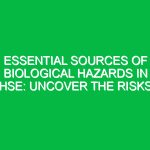Introduction
Hello team, and thank you for gathering today for this important toolbox talk. Our focus today is on a critical issue that affects our health and Safety on the job—Occupational-related Cancer. This term encompasses various cancers that arise from workplace exposures, and understanding it is essential for ensuring our collective well-being. Let’s dive into the details, talk about its implications, and discuss the roles we all play in Prevention.
Understanding Occupational-related Cancer
Occupational-related Cancer refers to cancer types that can develop due to exposure to hazardous substances or conditions in the workplace. This includes, but is not limited to, carcinogens like asbestos, benzene, formaldehyde, and certain forms of radiation. Each of these substances can increase the risk of different types of cancer, making it crucial for us to recognize and mitigate these risks.
According to the World Health Organization, approximately 4% of all cancers are attributed to occupational exposures. While this might seem small, it represents a significant number of preventable cases when considering the global workforce. Understanding how these cancers develop and the risk factors involved can help us take proactive steps toward prevention.
Key Risk Factors for Occupational-related Cancer
Let’s explore some of the primary risk factors associated with Occupational-related Cancer. Recognizing these factors is the first step in prevention:
- Exposure to Carcinogens: Substances like asbestos, coal tar, and certain heavy metals are well-known carcinogens. Regular exposure can significantly increase cancer risk.
- Radiation Exposure: Workers in certain fields, such as healthcare or nuclear energy, may be exposed to ionizing radiation, which is a known risk factor for developing cancers.
- Prolonged Exposure: The longer you are exposed to hazardous materials, the higher your risk. Understanding the cumulative Effects of exposure is crucial.
- Inadequate Protective Measures: Using proper Personal Protective Equipment (PPE) and adhering to Safety protocols can significantly reduce the risk of exposure.
Real-Life Examples
To bring this conversation closer to home, let’s consider a couple of real-life scenarios:
Example 1: Asbestos Exposure
In construction, workers may encounter asbestos, a known carcinogen. Many older buildings still contain this material. If appropriate protective measures are not taken, workers could be inhaling asbestos fibers, which may lead to lung cancer or mesothelioma years later. The key takeaway here is the importance of using proper PPE and following Safety Guidelines when working in environments with potential asbestos exposure.
Example 2: Chemical Exposure in Laboratories
In a laboratory setting, employees might work with chemicals like formaldehyde or benzene. If not handled correctly, these substances can increase the risk of cancers, including leukemia. Ensuring that safety data sheets (SDS) are reviewed and that all safety protocols are followed is vital for minimizing these risks.
Best Practices for Prevention
Now that we understand the risks, let’s discuss some Best Practices to reduce the chances of Occupational-related Cancer:
- Use Personal Protective Equipment (PPE): Always wear appropriate PPE, such as gloves, masks, and protective clothing, based on the Hazards present in your work area.
- Follow Safety Protocols: Adhere strictly to all safety guidelines and protocols in your workplace. This includes proper handling, storage, and disposal of hazardous materials.
- Engage in Regular Training: Participate in safety training sessions and stay informed about the latest safety practices concerning carcinogen exposure.
- Report Unsafe Conditions: If you notice any unsafe conditions or practices that could lead to exposure, report them immediately to your supervisor.
Regulations and Standards
Compliance with Regulations regarding Occupational-related Cancer is essential. Organizations like OSHA (Occupational Safety and Health Administration) set standards to protect workers from hazardous exposures. Familiarize yourself with these regulations, as they not only guide safety practices but also ensure legal compliance.
For example, osha mandates that employers assess workplace Hazards and implement Control Measures to minimize exposure to carcinogens. Failure to comply can not only endanger employees but also lead to significant penalties for the organization.
Creating a Culture of Safety
It’s vital to foster a culture of safety within our organization. This begins with open communication. Make it a point to discuss any safety concerns or questions during our toolbox talks. Encourage your coworkers to do the same. By sharing knowledge and experiences, we can better protect ourselves and each other.
Engaging Employees in Safety Practices
Engagement is key to ensuring everyone is aware of the dangers associated with Occupational-related Cancer. Here are some actionable steps to get involved:
- Participate in Safety Committees: Joining safety committees can provide a platform for discussing occupational hazards and developing strategies to combat them.
- Conduct Daily Checks: Before starting work, check your area for potential hazards. This includes ensuring that PPE is available and in good condition.
- Encourage Peer Discussions: Hold informal discussions with your coworkers about safety practices and share personal experiences related to occupational hazards.
Open-Ended Discussion
Before we wrap up, I’d like to open the floor for questions and discussions. What experiences have you had related to Occupational-related Cancer? Are there any specific situations you think we need to address further? Your input is invaluable.
Conclusion
In conclusion, understanding and combatting Occupational-related Cancer is a collective responsibility. By recognizing the risks, adhering to safety practices, and engaging in open communication, we can create a safer workplace for everyone. Remember, your health is your wealth, and taking these Precautions not only protects you but also your coworkers.
Thank you all for your attention and commitment to safety. Let’s continue to support each other in recognizing and mitigating risks related to Occupational-related Cancer as we move forward in our work. Stay safe!


